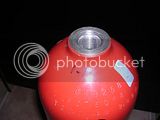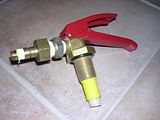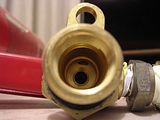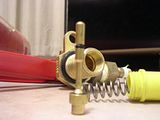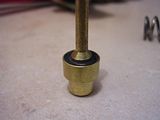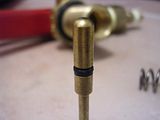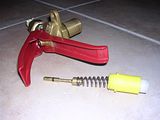cooperplace
Well-Known Member
- Joined
- 24/12/03
- Messages
- 130
- Reaction score
- 6
Like lots of people, I use a fire extinguisher (with pickup tube removed) to gas my kegs. I squeeze the 2 levers to turn on the CO2. BUT, the tiny little valve inside is doing a completely different job from that which it was designed for. As an extinguisher, it has intermittent use at most, but I use it all the time. So I'm having to have the valve rebuilt every time it is refilled.
Why not fit a screw down valve, you say?
First, the valves used on beverage CO2 cylinders are completely different and don't fit.
I've spent the day on the phone and at the workshop of my friendly fire extinguisher guy, trying to work out how to do it. He told me that there about 8 different threads on C02 extinguisher cylinders in Australia, not including aluminium-bodied valves, now condemned.
My extinguisher is a 3.5kg Chubb, made in Sydney in 1988. It's aluminium, they nearly all are. What sort of thread does it have? I called Chubb, and eventually found someone in Chubb Melbourne who told me that they were made for Chubb by CIG, now BOC. I called BOC, an exercise in frustration until I got onto the wonderful Eleanor in customer service who said that the extinguisher factory was taken over by Luxfer in 1989, and gave me the Luxfer number.
So I called Luxfer and spoke to a very switched-on lady, I don't know her name, who said, yes, it will have either a 1" taper, 14 threads/inch, or a parallel thread, 3/4" NGS. And that if the flange on the valve is pushed down hard onto the shoulder at the top of the tank (no threads showing), it is parallel. If threads are showing (they're not) it is taper. The numbers stamped on the extinguisher don't help, she said, as CIG used the same numbers for two different extinguishers.
As an aside, blokes, please note that the best information came from the two ladies I spoke with.
Interestingly my extinguisher guy has given me a lever-type valve identical to mine (my cylinder is stilll half-full so I'm leaving it alone for now) and I found that a 3/4" BSB female compression fitting screws 99.9% perfectly onto it. It just seems a teensy weensy bit loose. Is that acceptable with CO2 under pressure?? Ha ha I think not.
So now I know that my cylinder has the very unusual 3/4" NGS (national gas straight, a US std) so I must get a valve with that, and an Oz type 30 outlet. What are my chances?
I am trying Gas Cylinders UK who claim they can find a valve for any thread
http://gascylindersuk.co.uk/store/catalog/...b6fac0a6aa5b6b8
but I'm not holding my breath.
I could go mad if this goes on. It might be easier to buy Ebay item 280345152266, 2.6 kg cylinder for sale for $149.95 from Beerbrewonline, (complete with screw down valve) and they have regulators for $60, great prices. BTW I have no affiliation whatsoever with these people, indeed I've never spoken with them.
If I get a good reply from Gas Cylinders UK when I call them tonight, I'll do another post asking if anyone else can use such a valve.
Meanwhile, does anyone know of some place local where I could get a CO2 screw-down valve with 3/4 NGS on the cylinder side and type 30 on the outlet?
Peter
Why not fit a screw down valve, you say?
First, the valves used on beverage CO2 cylinders are completely different and don't fit.
I've spent the day on the phone and at the workshop of my friendly fire extinguisher guy, trying to work out how to do it. He told me that there about 8 different threads on C02 extinguisher cylinders in Australia, not including aluminium-bodied valves, now condemned.
My extinguisher is a 3.5kg Chubb, made in Sydney in 1988. It's aluminium, they nearly all are. What sort of thread does it have? I called Chubb, and eventually found someone in Chubb Melbourne who told me that they were made for Chubb by CIG, now BOC. I called BOC, an exercise in frustration until I got onto the wonderful Eleanor in customer service who said that the extinguisher factory was taken over by Luxfer in 1989, and gave me the Luxfer number.
So I called Luxfer and spoke to a very switched-on lady, I don't know her name, who said, yes, it will have either a 1" taper, 14 threads/inch, or a parallel thread, 3/4" NGS. And that if the flange on the valve is pushed down hard onto the shoulder at the top of the tank (no threads showing), it is parallel. If threads are showing (they're not) it is taper. The numbers stamped on the extinguisher don't help, she said, as CIG used the same numbers for two different extinguishers.
As an aside, blokes, please note that the best information came from the two ladies I spoke with.
Interestingly my extinguisher guy has given me a lever-type valve identical to mine (my cylinder is stilll half-full so I'm leaving it alone for now) and I found that a 3/4" BSB female compression fitting screws 99.9% perfectly onto it. It just seems a teensy weensy bit loose. Is that acceptable with CO2 under pressure?? Ha ha I think not.
So now I know that my cylinder has the very unusual 3/4" NGS (national gas straight, a US std) so I must get a valve with that, and an Oz type 30 outlet. What are my chances?
I am trying Gas Cylinders UK who claim they can find a valve for any thread
http://gascylindersuk.co.uk/store/catalog/...b6fac0a6aa5b6b8
but I'm not holding my breath.
I could go mad if this goes on. It might be easier to buy Ebay item 280345152266, 2.6 kg cylinder for sale for $149.95 from Beerbrewonline, (complete with screw down valve) and they have regulators for $60, great prices. BTW I have no affiliation whatsoever with these people, indeed I've never spoken with them.
If I get a good reply from Gas Cylinders UK when I call them tonight, I'll do another post asking if anyone else can use such a valve.
Meanwhile, does anyone know of some place local where I could get a CO2 screw-down valve with 3/4 NGS on the cylinder side and type 30 on the outlet?
Peter





